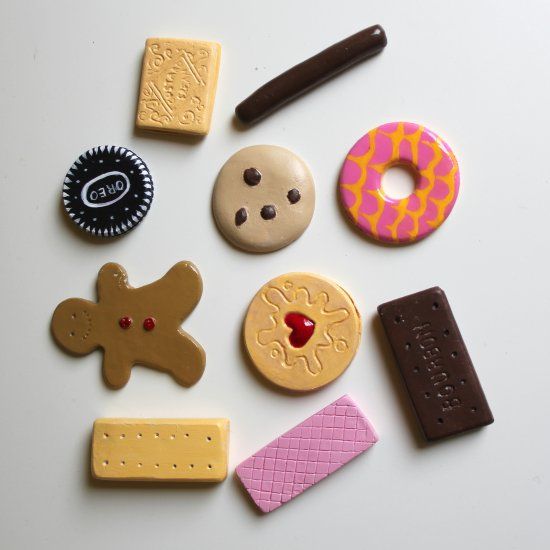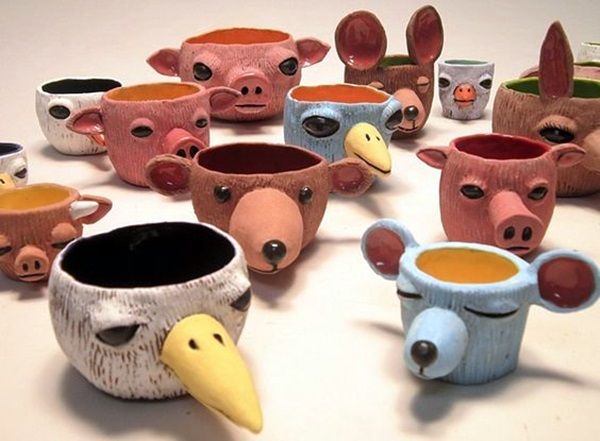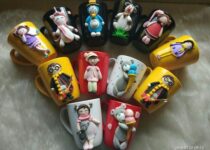Things to Make Out of Clay
Perhaps you’re the parent of a youngster who is always coming up with fresh ideas and works of art. Or maybe you’re looking forward to a lengthy vacation from school. Whatever the case, if you’re interested in seeing what sorts of things children can make from clay, you’ve come to the perfect spot. Here are some fun things to do with clay that will keep the youngsters occupied.
Clay may be used to create various beautiful objects that children can enjoy. Children of all ages and skills may create anything from pinch pots to lifelike portrait sculptures. Kids may make a variety of fun creations with little more than clay and creativity. A kiln or a potter’s wheel is necessary for several other types of clay work.
Kids can create all sorts of things out of clay. Age is a significant factor in a person’s capacity to acquire new knowledge and follow directions. The most critical factor is simply that they are enjoying themselves.
Your kid’s work could seem like a disaster to you. But working with clay is a great way to encourage growth in kids.
Keep in mind that childhood messes are a necessary aspect of development. To add insult to injury, making a mess is fun! Clay is essentially muck, so you should dress accordingly.
Clay is appealing to individuals of all ages, is non-toxic, and is suitable for use around children. You’ll find helpful information about making various clay items on this page.
If you’re looking for a fun activity with your kids, check out this compilation of unique clay crafts. You might find inspiration for your original ideas here.
What can you make with Clay?
There are several uses for clay. Without special tools or skills, you can create many clay objects. Most often, clay is used to create bowls, plates, trinkets, candle holders, figurines, votives, jewellery, beads, and artwork. You may also make vases, cups, and mugs out of clay and decorate them.
To foster a child’s creative side, try introducing them to clay projects. Play dough and modelling clay are popular among children because of their vibrant colours and malleable consistency. Playing with clay has additional benefits for children’s development, including enhancing their fine motor abilities.
Clumsy Clay Insect
There are numerous creative projects kids may do with clay, such as this one. Making a clay caterpillar is a fun activity for kids. The caterpillar’s body is made up of tiny circles, so even a child could do it.
How to make it?
Create a white paper leaf form. Have your youngster use crayons to decorate the leaf. Discard the leaf-shaped piece you cut off. Now, get some green and brown play dough. How do you mould tiny, perfectly round clay balls in shades of green and brown?
Show your kid for clarity’s sake. Put in a request to have these balls linked in a rainbow formation. The first ball will serve as the caterpillar’s face, so use some black clay to form two little dots for the eyes. Behind the eyes, fashion a grin using black clay or thread.
Attach two short sticks to the caterpillar’s head, and then cover the tips of the sticks with a small ball of red clay to create the antennae. Using the paper leaf you made earlier, position the clay caterpillar, so it seems to be crawling over the surface. Similar coloured dough may also be used to fashion caterpillars.

Ceramic cones filled with ice cream.
An excellent concept for a kindergarten or first-grade clay modelling exercise. Clay may be used to make ice cream cones.
How to make it?
Round up some used cardboard toilet paper rolls that have been thrown away. Then, roll each of the cut-open corners into a cone shape. Maintain the cone’s form by stapling or glueing the flat side but if you by mistake put hot glue on wrong side then find out how to get rid of it easily and reapply on right place to make the rolls in perfect shape.
Decorate the cone with play dough figurines in various colours, each representing a distinct flavour of ice cream.
Tiny dots of a contrasting hue may stand in for sprinkles. After the cones are ready, the children may play ice cream vendor and client.
Cookies with fun shapes are cut out of them.
Children will have a blast with this creative approach to working with clay. You may get clay or play dough that hardens after 24 hours of air drying if your kids want to save the clay cookies they make.
How to make it?
Offer your kid a wide variety of plastic cookie cutters in forms like animals, hearts, stars, crescents, and so on. To make the play dough thinner, you may roll it out with a rolling pin. Cut out forms with the cookie cutter and let your child feel accomplished. The forms may be saved and used for subsequent play if air dried.

Shapes of pasta reminiscent of shells
One more fantastic clay project for kids. They will be astounded with how many unique clay imprints may be formed from everyday household items like spaghetti and seashells.
How to make it?
Have your child use a rolling pin to smooth up the clay. After that, you may give her a bunch of different pasta shells and shapes to play with. Tell her to use them to press down on the play dough before you take them away. Now is an excellent time to let the kid look at the pasta or seashell form she made. Doll shoes or toy animals may be used instead of real ones to create miniature prints.
Fruit Basket
This is just one example of the numerous imaginative clay projects suitable for 5-year-olds. They may need your assistance to make a colourful and lifelike arrangement of little clay fruits.
How to make it?
Use some brown play dough to fashion a cute little basket for your kid. Then you can assist your kid fashion an apple, a bunch of grapes, a banana, a pineapple, and a melon out of play dough coloured red, purple, yellow, and green. Create a more lifelike pineapple by drawing on it with a stick. To correctly recognize the shapes of the fruits, your youngster may require your aid.

Decoration of a Wall Mural
If your child is five or older, they should try this creative art project. Children may learn about recycling and reusing unwanted resources by constructing artwork out of old, dry play dough crumbles.
How to make it?
Get together a bunch of old, dried-out play dough in a rainbow of colours. Have your kid draw a garden scene with grass, trees, flowers, and the Sun on a sheet of white cardboard cut to the size of an A4. The next step is to paint glue within the lines using a paintbrush.
Your kid may make a colourful mosaic by sticking dry play dough pieces into the drawn shapes. The best way to show this off is to have it framed and hung on the wall.
Divinely inspired puppet shows
Children will like participating in this game. Using ice cream sticks and clay, you can make sun, star, and rainbow puppets that will keep your youngster entertained for a long time.
How to make it?
You’ll also need some coloured play dough, craft eyeballs, and craft sticks or ice cream sticks. Make a sun by rolling a big ball of yellow clay and sticking a craft stick in the centre. Make the Sun’s beams by flattening another ball of yellow clay and slicing it into long triangles.
Fasten them to the sun-like yellow ball. Then, to make a smiling mouth, you may place the rounded end of the craft stick into the yellow ball.
Use craft eyes to give the puppet a smile and a nose, then glue them on top of the lips. Flatten a lump of blue clay and use a star-shaped cookie cutter to cut out two identical star shapes for the puppet’s hands.
Put an ice cream stick in the space between the stars and decorate it with a face.
Construct a rainbow puppet by forming the seven colours into snakes and tying them into a bow. Firmly attach the craft stick to the underside of the rainbow. Produce a grin and some eyeballs
Leaves Shapes
Air-drying clay and clay that can be fired in an oven may be used for this. You may get supplies like this at any store specializing in arts and crafts.
How to make it?
Tell your kiddo to start by gathering some big, exciting leaves from the garden. Help your kid remove leaves from the yard. After that, help your kiddo roll out the clay with a pin.
The clay rollers should be flattened on two or three spots. Let her use these leaf impressions to stamp clay with all the different designs.
Before letting the leaf form set naturally, trim off any excess clay from the edges. Have your kid add colour to the clay leaves after they’ve dried. Let the paint dry thoroughly.
This painting was made for your kid’s room and may go there if you choose.

Dreadful Mud Snail
Kids can make bright clay animals. In addition to snails, you can teach your kid to construct butterflies, elephants, turkeys, mice, and turtles.
How to make it?
Make a snail by having your kid colour a piece of pasta cut into the form of a seashell or conch. The snail’s body may be made by rolling out a snake-shaped piece of clay and attaching a pasta shape or seashell in the centre. The user may craft eyes and antennae to give the snail a unique look.
Valuable magnets for home electronics
Use air-drying clay and a self-stick magnet to create colourful fridge magnets.
How to make it?
Tell your kid to mash together the various coloured lumps of clay. Shape the dough into desired forms, such as a heart, fish, star, or crescent, by rolling it out and cutting it using cookie cutters. It needs to dry and harden naturally. Then you may personalize your fridge by adding a magnet to the back of the form.
Clay play is popular among kids of all ages. Try one of these clay craft ideas if you want to encourage your kid to express his imagination.
Constructing a Pinch Pot with the Little Ones
Several distinct varieties of air-dry clay exist. To the untrained eye, several types of air-dry clay are indistinguishable from regular pottery clay; the only difference is that they harden when exposed to air. pinch pot is fun to make and easy for kids to construct. for its detailed steps read this post.
Polymer clay is yet another non-pottery clay that may be hard-baked in a regular household oven. It comes down to you deciding whether or not to sacrifice your kid.

IMPORTANT TIPS – Know Before You Begin
Once wet, clay has a strong adhesive quality. Clay will adhere to your kitchen counter if you try to roll it out or flatten it there. Your desk won’t be damaged, but it may be difficult to avoid breaking your kid’s pottery while picking it up.
Let your kid use a board or tray as a blank slate whenever possible. Just remove it after they’re done working on it. Once the clay is dry, it may be easily removed from the tray. You may use soap and water to clean the tray.
After you finish painting your clay with poster paint or acrylics and it’s dry, you may seal it. While the paint on your pottery won’t be waterproof, it will hold up to repeated washings. Use a clear varnish or other craft sealers to keep out moisture.
Conclusion
There are so many more fantastic clay projects for kids out there. Regarding what kids can create with clay, the truth is that there are no limits. Regarding modelling clay, kids of different ages have different skills. Those with varying degrees of competence might find satisfaction in working with clay.
My number one piece of advice is to ditch your expectations for your child’s abilities. The goal here is to lighten everyone’s mood and have smile on everyone’s face including kids and adults.
FAQ
-
How can I use dried clay?
If the clay pieces begin to dry up, seal them in a bag and spritz them with water. After many hours, close the bag. It is necessary to prepare the clay for use. You may reanimate the clay if you have larger pieces wholly dried up or if you desire to reuse previously unpainted objects.
-
What is the purpose of modelling clay?
Modelling clay is a collection of flexible materials used for sculpting and building by children, art students, enthusiasts, and professionals such as potters and animators. To shape and manipulate diverse materials, sculpting, mixing, texturing, thinning, scraping, poking, and cutting instruments may be used.
-
How widespread are clay earrings?
Currently, polymer clay earrings are pretty stylish and popular. Because they are easy and fast to construct, you may design them in any colour to match your outfit, some people also like to use acrylics over polymer clay earrings. In addition, you may fast produce them to sell for extra revenue.
-
Can glitter be put into clay that has been air-dried?
Add glitter to your creations while the clay is wet; children like this phase. Take care to surround the embellishment properly. Clay should be lightly pressed with glitter.

Being associated with art and craft field since decades as a hobbyist and life long learner has given me an opportunity to learn many new things related to art, craft, paints and pottery which i am trying to share with your guys on this website. I have expertise of being professional painter and potter for the last 20+ years
I have learned mind blowing cool tips and insights which makes me a person with ability to improvise and come up with creative ideas and solutions to make stunning and impeccable art pieces of all types which are adored by people across the globe on this website and other platform.


